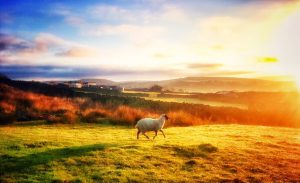The Rooley Moor area is made up of open moor, mire, bog pools, grassland, pasture and woods. Healey Dell is a Site of Biological Importance and Local Nature Reserve.
Plants in and around the area include heather, ferns, almond willow, bluebell, corn marigold, floating water- plantain, red threadwort (liverwort), fingered cowlwort (liverwort), earth-cup flapwort (liverwort), common kettlewort (liverwort), dotted thyme-moss, lesser cow-horn bog- moss and slender haircap.
Wooded areas contain oak, birch, beech and elm trees. Willow and birch scrub, ivy and bilberry is in evidence as is wax cap fungi.
The area and its surrounds contain a significant colony of common lizards and it is considered that some of the ponds could provide suitable habitat for frogs and the great crested newt. Stickleback and white-clawed crayfish is known to occur in the area.
Badger, brown hare, mountain hare, otter and water vole are active in the area. Roe deer are aslo becoming frequent visitors to the area.
Bats species include the common pipistrelle, daubenton’s bat, serotine bat and soprano pipistrelle.
Insects include dragonfly and bees. Moth species in and around the area include the cinnabar moth, small phoenix moth, dark-barred twin-spot carpet moth and the chimney sweep moth.
Bird species are numerous because our area has such a diverse landscape of Woodland, Water, River, open Moorland, big skies (Buzzard and Peregrine) and isolation. We have, as a minimum, fifteen ‘Red’ species and twenty ‘Amber’ species.
‘Red’ species – include Lapwing, Partridge, Curlew, Redwing, Fieldfare, Skylark, Tree and House Sparrow, Starling, Song Thrush, Mistle Thrush, Spotted Flycatcher, Grey Wagtail, Cuckoo and Twite.
‘Amber’ species include Bullfinch, Mallard, Dipper, Kestrel, Kingfisher, Hedge Sparrow (Dunnock), House Martin, Oystercatcher, Meadow Pipit, Redshank, Black Headed Gull, Redshank, Reed Bunting, Swift, Tawny Owl, Wheatear, Whinchat, Willow Warbler, Red Grouse and Green Woodpecker.
‘Green’ other ‘non-threatened species’ include Blackbird, Buzzard, Chaffinch, Coot, Cormorant, Carrion Crow, Rook, Ring Dove, Goldfinch, Goldcrest, Goosander, Black Backed, Common and Herring Gulls, Canada Goose, Heron, Jackdaw, Jay, Magpie, Moorhen, Nuthatch, Little Owl, Peregrine Falcon, Pheasant, Robin, Common Snipe, Sparrowhawk, Stonechat, Swallow, Blue Tit, Coal Tit, Great Tit, Long Tailed Tit, Pied Wagtail, Waxwing, Whitethroat, Greater Spotted Woodpecker, Wood Pigeon, Wren.
We also have the Whitworth Valley Anglers’ fisheries at Catley Lane Head and Broadley Wood. There is a diversity of fish species there including Bream, Barbel, Brown Trout, Common Carp, Mirror Carp, Ghost Carp, Crucian Carp, Chub, Ide, Orfe, Perch, Pike, Rudd, Ruffe, Stickleback and Tench.
Different breeds of cattle and sheep can be seen where commoners exercise their rights to graze.

